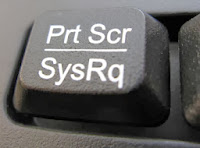I want to upload a snapshot of my laptop screen to my website. How can I create the snapshot and turn it into an image?
— Rinchen, aspiring web designer
Answer
Dear Rinchen,
Well, one foolproof way — though undesirable — is to stand with a digital camera in front of the screen and take a snap... Luckily, there are neater ways to take a screenshot. If you are using Windows XP and above, simply clicking on the the PrtScr (Print Screen) key captures a crisp image of the entire screen to the clipboard. Look for this forgotten key at the top-right area of the keyboard. On different keyboards the key label might be PrSc, Prt Scn, etc.

Now that the image is in the clipboard, you can paste it inside various applications, such as a Word document or a PowerPoint presentation. You can even paste it into the rather antiquated Paint application. Pasting the image to a PowerPoint slide is probably the most useful, since you can right click on the just-pasted image and select Save as Picture to export the screenshot to an image file in various formats (JPG, GIF, PNG, etc). You can also use PowerPoint’s photo editing capabilities (crop, resize) to edit the image before saving.
Tip: If you need to capture only the active window, as is often the case, clicking Alt-PrtScr (holding the Alt key while clicking PrtScr) will do the trick.
What about Smartphones?
Want to capture a witty SMS exchange and turn it into an image? It’s easy to take snapshots of your smartphone’s screen if you know the right key combination. On Apple gadgets, simply click on the round Home button together with the Lock button. You will hear a click, and a screenshot will be saved to your Camera Roll (iPhone) or Saved Photos (iPad, iPod).
Android users have it a bit more difficult. On most phones running Android 4 you will need to press the Volume Down key together with the Power key, then hold for about 5 seconds. Not easy for people with small hands! You will then hear a click and the screenshot will be saved to the Screenshots folder, which you can view (and share) with the Gallery app. On some Samsung phones, the Power+Home keys does the trick. If neither of these work on your phone, your best bet is to check the user’s manual or to Google it.
Want to capture a witty SMS exchange and turn it into an image? It’s easy to take snapshots of your smartphone’s screen if you know the right key combination. On Apple gadgets, simply click on the round Home button together with the Lock button. You will hear a click, and a screenshot will be saved to your Camera Roll (iPhone) or Saved Photos (iPad, iPod).
Android users have it a bit more difficult. On most phones running Android 4 you will need to press the Volume Down key together with the Power key, then hold for about 5 seconds. Not easy for people with small hands! You will then hear a click and the screenshot will be saved to the Screenshots folder, which you can view (and share) with the Gallery app. On some Samsung phones, the Power+Home keys does the trick. If neither of these work on your phone, your best bet is to check the user’s manual or to Google it.
Snip, Snip
The Snipping Tool is a great tool that makes it easy to take a snapshot of any area of the screen. The tool is automatically available to the lucky users of Windows Vista, Windows 8, and certain versions of Windows 7 (Home Premium and above). To run, simply click the Start button, then start typing Snipping Tool.
The Snipping Tool is a great tool that makes it easy to take a snapshot of any area of the screen. The tool is automatically available to the lucky users of Windows Vista, Windows 8, and certain versions of Windows 7 (Home Premium and above). To run, simply click the Start button, then start typing Snipping Tool.
Readers are encouraged to submit technology-related questions to boaz@thimphutech.com
No comments:
Post a Comment
We love to hear from our readers!
Comments are reviewed before being published, so it might take a few hours before you see your comments posted.
Note: Only a member of this blog may post a comment.